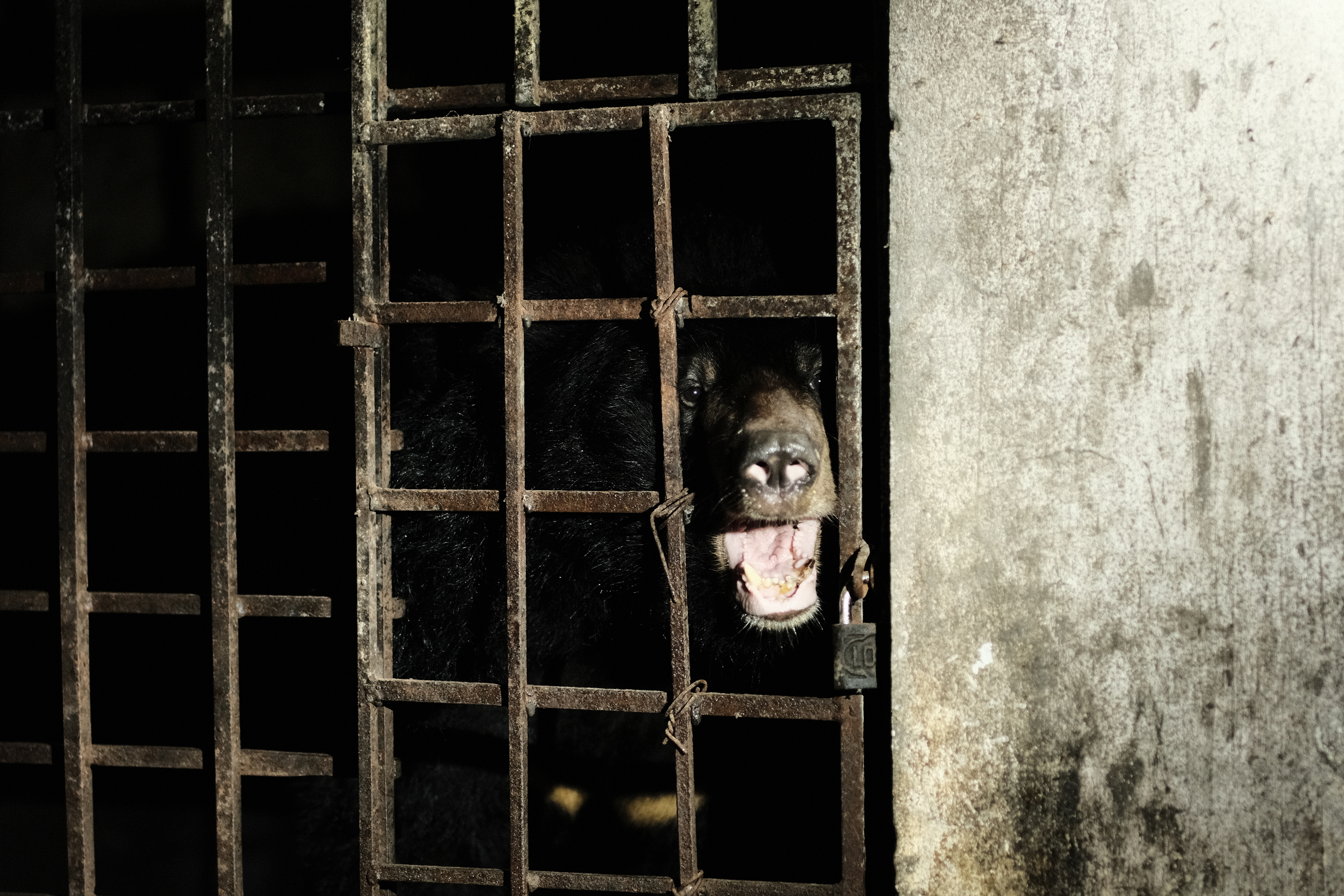
History of the Bile Bear Trade in Vietnam and How FOUR PAWS Are Working to End It for Good
Getting all remaining bile bears to safety and shutting down farms across Vietnam
It’s difficult to imagine the horror of bile bear farms without seeing them for yourself. Imagine small, rusted metal cages only slightly bigger than the bears they constrain. The cages are either partially or fully exposed to the elements, and do not contain a bottom (just bars), bedding or toys for enrichment. Some bears spend day-in and day-out pacing back-and-forth (as much as their cage allows) or attempting to gnaw their way through the bars to escape. Some bears just sit lethargically in their cages. Most bile bears have been living in these cages since they were cubs. This usually involves the female mother bears being killed so that cubs can easily be taken. The first months of their lives, the cubs are often used as pets or toys. After they had become older and bigger and more dangerous, they end up in bear farms or in cages and conditions that resemble bear farms, to be kept as pets.
Sadly, this reality of bear bile farming has been prevalent throughout Vietnam and other regions of Asia for hundreds of years. The suffering these bears experience is immense.
Yet change is happening, and pressure is mounting on Vietnamese authorities to crack down on the bear trade and bile farming. But what is bear bile, why is it traded, and what is FOUR PAWS doing to help put a stop to it?

What is bear bile and what is it used for?
Bear bile is a substrate extracted from the gallbladders of Asiatic Black Bears, Sun Bears and brown bears. In Vietnam, the bear species most farmed for bile extraction is the Asiatic black bear, also known as a moon bear.
Bear bile has been used in Traditional Medicine for thousands of years, with the first reference appearing in an eighth century medical text prescribing bear bile for conditions such as epilepsy, haemorrhoids, and heart pain. However, it wasn’t until the early 1900s that scientists discovered that bear bile, a fluid that's secreted by the liver and stored in the gallbladder, contains a significant amount of Urso deoxycholic acid which has been medically proven to help dissolve gallstones and treat liver disease1.
Sadly, bear bile has also been marketed as a cure for conditions like cancer, colds, and hangovers, even though there is no scientific evidence supporting its effectiveness for these ailments2. In addition to being found in traditional medicinal products, bear bile is also frequently found in Asian cosmetics and food products such as shampoo, eye drops, toothpaste and wine.

Synthetic and herbal alternatives to bear bile have existed since the 1950s, yet despite these effective alternatives, bear bile is still being used in Traditional Medicines.
How is the bile harvested from the bears?
There are a few different ways which bear farmers will attempt to extract bile from the gallbladder – all performed without proper pain relief causing the bears immense stress and agony.
In Vietnam where the extraction of bile is forbidden, usually an inconspicuously method – from the outside – is being used. Therefore, the gallbladder is being localised by ultrasound, and after that, the bile is extracted using a catheter and pump or a syringe. The bears are anaesthetised although quite often this procedure is not done correctly and is ineffective. This is documented in video footage where bears can be seen and heard to be in distress when extraction takes place.
What affect do bile extractions have on the health of the bears?
Sadly, the Asiatic black bears that are kept on bile farms are permanently caged. Because they never leave the confinement of their small cages.
Due to frequent extractions, most of the bile bears suffer from chronic liver and gallbladder disease and frequently develop secondary complications like liver cancer. The bile farming and extraction practice puts great stress on the physical and mental health of the bears, which eventually leads to their death. Moreover, inappropriate keeping conditions, poor diet, and exercise depravation contributes to mobility problems, wasted muscles and obesity. In addition to this, the constant mistreatment, unstimulating environment, and confined space leads to behavioural disorders. Due to their immense suffering and boredom, the bears often chew on their cage bars in attempt to escape, which results in broken and damaged teeth.

Our Project Coordinator for bear rescues, Magdalena Scherk-Trettin, who has witnessed bear farms in Vietnam: “The cages are extremely tiny, scarcely larger than the bears themselves and completely devoid of stimuli. The bears lack everything. They are ill and lifeless. I have seen animals that could not even lie down properly in their cage. They had to sleep in a sitting position. Bears kept on these farms usually have no access to water. This is extreme cruelty to animals”.


Why has the practice of extracting bear bile still been allowed to take place in Vietnam? (legalities)
In 2005, Vietnam outlawed the possession, sale and extraction of bear bile, yet despite the ban, farmers were allowed to keep their bears, so long as they were microchipped and had been registered before 2005.
Many of the farmers who were allowed to keep their bears, have continued performing these deadly bile extractions despite it being illegal. In order to stop these extractions happening altogether, FOUR PAWS are working to rescue the bears remaining on bile farms, and working with local authorities to enforce stricter regulations.
How many bile bears are still in captivity on bile farms in Vietnam and what is being done to rescue them?
As of end-May 2023, 228 bears remain on 76 farms across Vietnam. Most of these bears spend a sad existence in tiny metal cages still undergoing painful bile extractions.
For over 15 years, Vietnam’s government, together with NGOs, have been fighting to end the cruel practice of bear bile farming in Vietnam. Collective efforts have resulted in a 94% reduction in the number of bile bears in Vietnam, from 4,300 bears recorded in 2005 to 228 bears on bear farms by end of May 2023. Many bear owners across the country have voluntarily given up their bears thanks to great efforts made by local authorities.

However, while significant progress has been made across the country, Hanoi remains the country’s #1 bear bile farming hotspot, with 115 bears on 22 farms accounting for 54% of the total bile bears in Vietnam! Of the 115 bears being kept at 22 Hanoi farms, 92% are kept in the rural district Phuc Tho alone, with 106 bears being kept there on 17 farms (all figures refer to end of May 2023).
Instead of leading the nation in efforts to end bear bile farming in Vietnam, Hanoi – Vietnam’s capital city – is way behind the rest of the country. While many other provinces have been working hard to end bear bile farming, Hanoi province has shown little improvements in efforts to deal with this industry, reflecting poorly upon overall efforts by the government to phase out bear bile farming throughout the rest of the country.
What is BEAR SANCTUARY Ninh Binh and why is it so important?
FOUR PAWS provides a species-appropriate forever home for former bile bears and bears who fell victim to the illegal wildlife trade at BEAR SANCTUARY Ninh Binh. The sanctuary has multiple spacious outdoor enclosures, three bear houses with indoor dens, a quarantine station, a full-equipped veterinary unit, a feeding kitchen and an administrative building.
The BEAR SANCTUARY Ninh Binh is currently home to 45 bears who are now able to live in safety with grass under their paws, fellow bears to play with and all the food they can eat. Our sanctuary is a safe haven for former bile bears who we are unable to release back into the wild due to their reliance on humans and lack of instinctual survival skills. Many of the bears we rescue from bile farms require ongoing medical care for the remainder of their lives due to extensive organ damage and health issues caused by the bile extraction process.
BEAR SANCTUARY Ninh Binh is open to visitors on a daily basis. Sanctuary guides tours are offered and from the 300-meter-long skywalk, visitors can observe the bears living peacefully in their naturalistic outdoor enclosures. From here, people can also experience the first bear exhibition in Vietnam and learn about the characteristics of the bear species as well as the problems they are facing in the modern time.
What are the next steps in our plan to contribute to an end of bear farming in Vietnam?
Our future work in Vietnam includes:
- The rescue of more bile bears and their admission to our BEAR SANCTUARY Ninh Binh.
- Close cooperation with local animal welfare organisations, as well as local and national authorities.
- Comprehensive educational work on the topics of wildlife, nature and environmental protection.
- National and international educational work with the goal of reducing the demand for bile products and informing about the suffering of bears on bile farms.
Source
2 National Geographic
3 National Geographic, https://www.nationalgeographic.com/animals/article/bear-bile-explained, Last accessed 8/7/22








